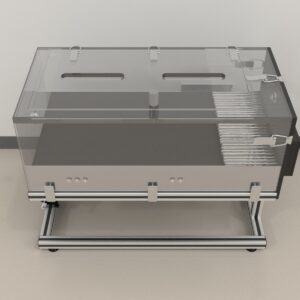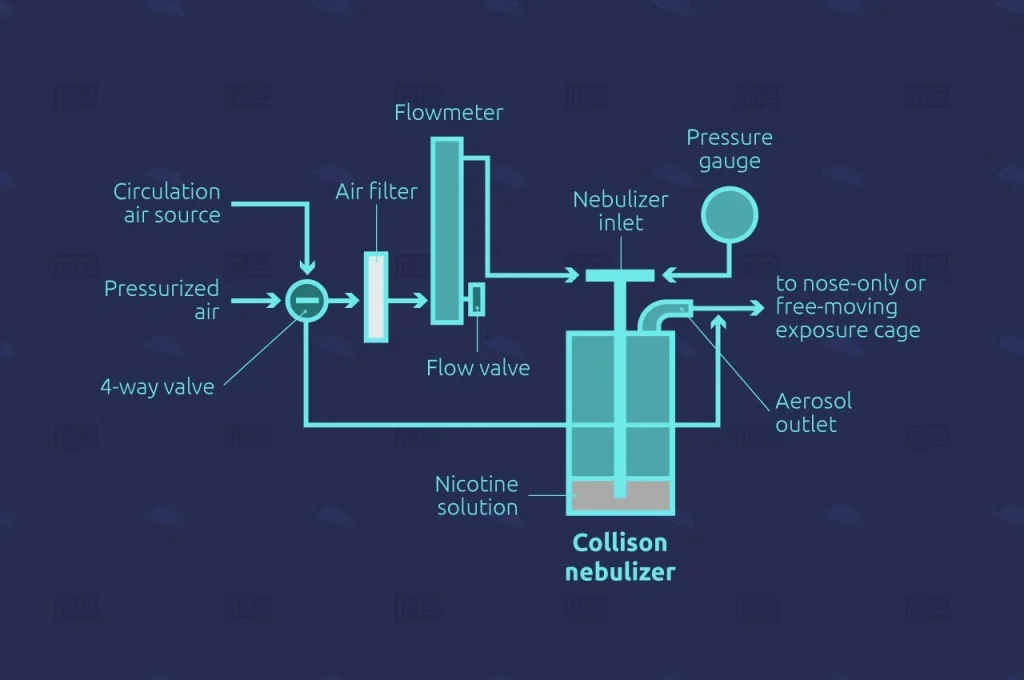$7,790.00
The AeroDeliver™ system is a cutting-edge, noninvasive tool designed for high-throughput research on nicotine addiction, toxicology, teratogenicity, and tobacco-related diseases in rodents. This system utilizes nose-only and free-moving exposure devices to deliver targeted aerosol directly to the alveolar region of the rodents. Researchers can precisely control drug delivery through nose-poke or lever-press mechanisms. The system ensures that drug vapors are safely and consistently maintained at desired levels with minimal equipment, facilitating the study of drug dependency behaviors through noninvasive aerosol administration.
The aerosol delivery chamber offers precise control over the quantity of aerosols reaching the rodent’s systemic circulation and brain. By providing access to substance vapors in individually controlled small chambers, the AeroDeliver™ system addresses the challenge of administering substances to rodents. It also supports multiple dosing schedules and delivery methods within the same group of animals. Importantly, the system allows for the collection of biological samples and administration of test compounds without disrupting the drug exposure or environmental conditions.
Compact and user-friendly, the vapor chambers are suitable for any laboratory setting and require only minimal training for use. This system supports extended experiments ranging from weeks to months without the stress associated with injections or pump implants. The AeroDeliver™ system is compatible with both rats and mice, with chamber sizes adjusted accordingly.

MazeEngineers empowers preclinical neuroscience research with meticulously designed, customizable behavioral apparatuses. From manual classic mazes to fully automated smart systems, we provide the tools scientists need to capture high-quality, reproducible data for studies on learning, memory, anxiety, and depression.





The AeroDeliver™ system is equipped with a collision nebulizer capable of producing aerosols with precise size distribution profiles. It features two airflow meters with valves to monitor and regulate both the airflow rate and the pressure applied to the nebulizer, along with an air pressure gauge. Additionally, the system includes nose-poke-operated mechanisms for administering food and drugs. Data collected from the aerosol delivery system is analyzed using CageCenter™ software, which provides two pre-configured modes for aerosol delivery.
The AeroDeliver™ system uses pressurized air from the laboratory’s air source to generate aerosols through the nebulizer. This air pressure controls the aerosol flow, droplet size distribution, and concentration. The nebulizer’s output is directed into a sealed exposure chamber—a plastic cylindrical tube with an inner diameter of 19.7 cm and a length of 25.4 cm—equipped with a platform for the rodents. This chamber simulates a home-cage environment, allowing rodents to move freely during extended research sessions. Throughout the experiment, both the aerosol flow rate and air pressure are meticulously regulated to ensure precise and stable drug delivery.
The associated software evaluates three key parameters to analyze the drug’s toxicity, teratogenicity, and pharmacological effects: Elapsed time, Aerosol events (opening and closing), and Food administration events.
Note: For experimental accuracy, put one rodent into the sealed cage at a time.
Shao et al. employed lung alveolar region-targeted aerosol technology to administer nicotine to rodents. In their approach, they controlled the nicotine aerosol concentration and exposure duration to accurately dose and stabilize the delivery for precise pharmacokinetic measurements. The rats were exposed to the nicotine aerosol for 2 minutes. The findings indicated that this aerosol delivery system is a noninvasive and effective tool for rapidly introducing a controlled amount of nicotine into the rodents’ bloodstream and brain, producing dose-dependent pharmacological effects, including at lethal doses. The technology mimics nicotine kinetics in both arterial and venous blood similar to human smoking. The AeroDeliver™ system is suitable for studying the effects of chronic intermittent nicotine exposure, nicotine addiction, toxicology, tobacco-related diseases, and for evaluating new drug candidates.
Nicotine enhances brain stimulation reward, boosts locomotor activity, and induces conditioned place preference in rodents, marking it as the primary addictive element in tobacco. The nicotine vaporizer or aerosol delivery system, known as the SmartCage™, is a modular device that allows researchers to simulate tobacco smoking without the need for smoke inhalation. This device offers an alternative to traditional cigarettes by delivering vaporized nicotine directly to the user.
The purpose of the study was to develop a method to achieve blood nicotine levels in rodents that closely mimic those found in humans and induce dependence. Kallupi and George utilized the aerosol delivery system to administer nicotine vapors in a controlled, stable, and consistent manner, also analyzing the vaporized air for nicotine concentration. This noninvasive, high-throughput technique replicates the intermittent nature, duration, and route of nicotine exposure seen with e-cigarettes in humans. The study confirmed that the nicotine vapor system reliably maintains stable nicotine vapor levels in the air with minimal equipment.
The study aimed to develop a device that mimics smoking-related nicotine exposure. Shao et al. created an aerosol delivery platform linked to a computer-controlled program, which exposes freely moving rodents to intermittent nicotine vapors based on a customizable schedule. This system can accurately characterize the vapors within the rodent’s breathing zone, with droplet sizes falling within the respirable range for the animals. It allows researchers to produce a broad spectrum of nicotine concentrations in the air, catering to various experimental requirements.
The nicotine levels and circadian patterns achieved through this system closely resemble the pharmacokinetic profiles observed in human smokers. The AeroDeliver™ system is designed to expose unanesthetized and unrestrained rodents to chronic, intermittent nicotine exposure, ultimately mimicking the circadian blood pharmacokinetics of human smoking. The results demonstrated that this aerosol delivery system is an innovative and valuable tool for studying rodent behavior, pharmacology, and toxicology related to chronic nicotine exposure, nicotine addiction, tobacco-related diseases, teratogenicity, and for the identification of potential therapeutic agents.
Kallupi, M., & George, O. (2017). Nicotine Vapor Method to Induce Nicotine Dependence in Rodents. Current Protocols in Neuroscience, 80, 8.41.1–8.41.10.
Shao, X. M., Liu, S., Lee, E. S., Fung, D., Pei, H., Liang, J., . . . Xie, X. S. (2017). Chronic intermittent nicotine delivery with lung alveolar region-targeted aerosol technology produces circadian blood pharmacokinetics in rats resembling human smokers.
Shao, X. M., Xu, B., Liang, J., Xie, X. (., Zhu, Y., & Feldman, J. L. (2013). Nicotine Delivery to Rats via Lung Alveolar Region-Targeted Aerosol Technology Produces Blood Pharmacokinetics Resembling Human Smoking. Nicotine & Tobacco Research, 15(7), 1248–1258.
There are no questions yet. Be the first to ask a question about this product.